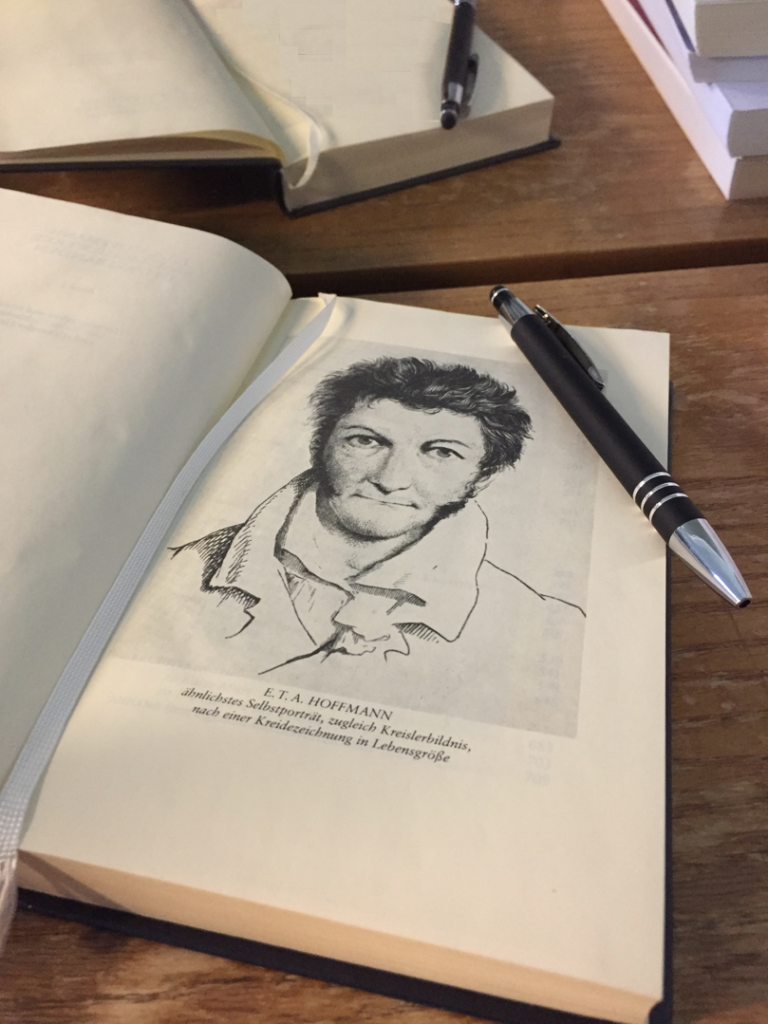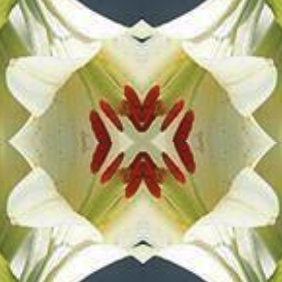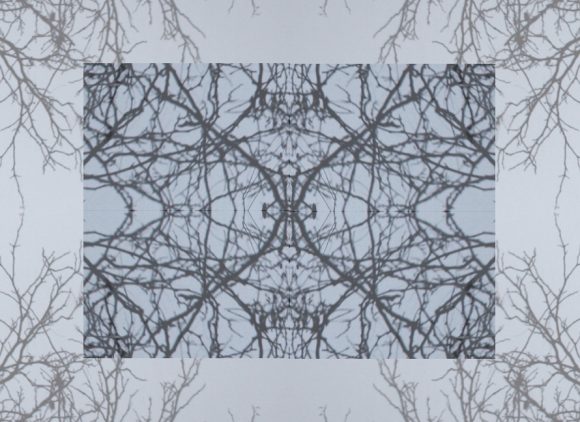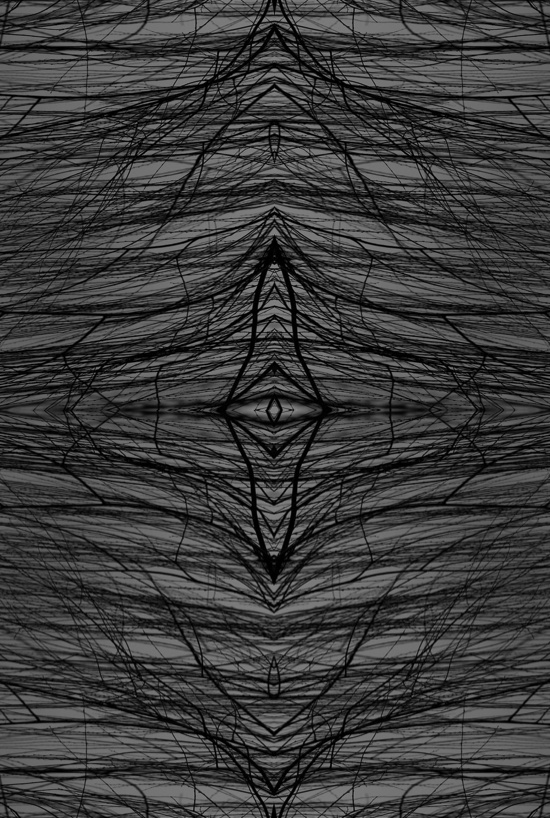The adventure is kicked into motion by an episode of emotional upheaval (and we know where that leads): a surprise meeting with Julia, an old flame, at the New Year’s party. Romantic memories awake, then confusion arises when she acts somewhat coldly but also, it seems, with some recognition, and finally deep disappointment fuels the mix at her husband’s appearance. This is too much: it all explodes, our hero snaps and runs off — leaving his hat and coat behind — into the cold winter night.
He ends up in an obscure Bierkeller and meets two curious men, who engage him in a bizarre conversation. Yet as the night deepens, the strangeness of the talking rather seems the least remarkable thing. Fantasy creeps into the story world. One of the men, it turns out, has lost his shadow. The other departs in a hurry, only to reunite with our hero in a hotel where they are — strange coincidence! — accidentally booked to share a room. It emerges that this man also has lost something: namely, his mirror image!
The adventure we’re following here is from E.T.A. Hoffmann’s novella, Abenteuer in der Silvesternacht. And we are not done yet, of course: things will get weirder still, including a dream report and a story-in-a-story which gives an account of that peculiar loss of mirror image.

1. It’s impossible to sort it all out, but we can quickly move a few things out of the way, before we proceeed to the stuff that is the focus of this blog.
To begin with, one of the two men our hero meets at the pub has lost his shadow. That is interesting enough in itself, but it belongs in another story — I think it is mostly Hoffmann having fun with intertextuality. (Peter Schlemihl, the man who sells his shadow to the devil, is the protagonist of a famous novella by Chamisso.)
Then there are various interconnections between the frame narrative (the party, pub, and hotel settings) and the embedded narratives: the dream report and the story-in-a-story in which Erasmus Spikher forfeits his mirror image. The most remarkable is of course the apparent identity of the woman: Julia and Giulietta do not merely have the same name (in its German and Italian variants), but the description of their appearances at the parties where the hero meets them is nearly identical, down to the phrasing and the similes: they both wear a “weißes, Busen Schultern und Nacken nur halb verhüllendes Gewand, mit bauschigen, bis an die Ellbogen streifenden Ärmeln”, and they appear “anzusehen wie die Jungfrauen auf den Gemälden von Mieris” (137, 126; compare 134 as well). And the connections go further: they both proffer a filled goblet which either narrator unquestioningly takes and empties, upon which they feel a fire streaming through their veins (127, 138; and also in the dream report: see 134). In other words: a strong symbolism and massive energy surrounds them, at least as perceived by our hero (and Spikher).
2. Now I could make a quick and cheap point here if I said: “the embedded worlds mirror the world of the frame narrative”. But such loose analogical thinking will soon end in empty talk where everything seems to be connected with everything else.
It would also be inaccurate. For one thing, the characters of Giulietta and Dapertutto in the embedded worlds are very active forces who pursue elaborate plots, whereas the figure of Julia is a projected image which has only a momentary impact (the dynamic in the frame world unfolds from the actions, however impulsive, of the narrator — not Julia’s). For another, in the inner world, things are at stake for the main protagonist: a marriage, a family, a moral conscience on one side, romantic passion and monstrous criminal deeds on the other; in the frame narrative we’re just dealing with a single night’s fleeting experience (however emotionally intense and memory-laden). There is a lot here that needs unpacking, and relationships between the ‘inner’ and ‘outer’ events can and should be explored. But doing so along a crude analogy, coming from a superficial similary, would not do justice to the complexity of Hoffmann’s work.
Analogies may feel compelling; but then often enough, when examined in more detail, they simply dissolve. The reason is that, if we only take a quick look at the surface, we may notice some similarities (that is what triggers the analogy thinking). But when we take a second look, and examine things more closely, we often find more differences than similarities, and the analogy turns out to have been spurious. (That is why fans of analogical “reasoning” frequently insist on moving quickly from one thought to the next: their claims have a short half-life.)
The inner world is not a mirror of the outer world. But there are still these connections, evidently planted with some intent by Hoffmann. What are we to make of them? What do they tell us about the relationship between, on the one hand, the (‘outer’) realm, the narrated world of the Julia episode, the pub conversation, and the later episode in the hotel, and on the other hand, the ‘inner’ worlds of the dream and of the story-in-the-story?
3. What, in fact, are these two worlds? What is the difference between the two realms?
At first glance, we might think it is the contrast between, on the one hand, the world of the ‘real’ — of common sense and intersubjectively comparable things and events — and, on the other, the world of fantasy: dreams, stories, and perhaps delusions. Yet the ‘outer’ world is not free of fantasy elements: the character of Peter Schlehmil appears without a shadow, and Erasmus Spikher (here called “General Suwarow”) has no mirror image here just as he has in the story-in-the-story on the ‘inner’ level. There is a strange overlap here, a kind of blurring of the borders (which is of course a well-known characteristic of Hoffmann’s work).
What Hoffmann’s narrative does is more than just blurring the line, however. It gradually moves us from the world of common sense into the realm of fantasy. The fantastic sneaks in, piece by piece. First, in the Julia episode, there is a lot of emotional upheaval and surprise going on, but nothing out of the limits of ordinary experience. Secondly, in the pub scene, we have a lot of ominous, unexplained behavior: weird and exotic. Only at the end of that episode we are hit with the unambivalently fantastic element: the narrator sees with his own eyes that Schlemihl really has no shadow. The third episode (at the hotel) stacks the deck further by demonstrating to the narrator that, “really”, the same non-existence adheres to Spikher’s mirror image (it also embeds the dream report). With the fourth chapter, which now fully consists of the background story of Erasmus Spikher, we have fully switched into story mode, up to the end (which is, in a nice touch, formally announced as “The End of the Tale of the Lost Mirror Image” in the printed text).
In this manner, Hoffmann’s narrative subverts the starkly different structures of the commonsense realm vs. the dream world, and achieves the literary effect of “blending the real with the fantastic”, which is a commonly noted characteristic of his writing.
4. And then he compounds the effect by adding the mysterious correspondences which I have noted above. (Such correspondences as stylistic means have a long and distinguished tradition, both before and after Hoffmann; just think Goethe’s Wahlverwandschaften or Mann’s Tod in Venedig, for which I have analysed it elsewhere as prefiguration technique.)
Thus I think the best way to look at these connections (such as the Julia/Giulietta identity) is to see them as narrative device to produce the uncanny effect of “the fantastic creeping into the ordinary world”, the Hoffmannesque “blurring” of the lines between the real and the dreamy-fictional. (In other words, I think that is where they belong, and therefore I shall not include them in my discussion of the symbolism of mirrors.)
5. Either way, the appearance of mirrors is a surefire sign that we move onto a symbolic level. Thus the Spikher story can be taken as a deeper account (perhaps a psychological unpacking) of the feeling of loss which the narrator has after meeting Julia at the party — one he describes himself, in the pub conversation, as a loss of “part of one’s self” (131). The parallel between the narrator’s loss and the losses which his two conversation partners have suffered (their shadow and mirror image, respectively) is clearly suggested in that passage. And the affective turmoil (as I have noted in the beginning) surely indicates that something psychological is going on here.
Most importantly, however: we must come to terms with what it means to “lose one’s mirror image”. What does this symbolize? What are — at the symbolic level, at any rate — the consequences? Why would one do it (or at least: let it happen)? That’s where we have to turn next.




[…] But things get darker soon. Once his wife realizes that he is without reflection, she leaves him. At this point, Dapertutto and Giulietta reappear and try to manipulate him into murdering his family. This fails, but it is a chilling demonstration of how severely Spikher’s options are restricted. He is trapped in a devilish dilemma: following through on his passion for Giulietta (which is really a demonically induced madness) would lead further down the road to crime, murder and betrayal — that’s what it really means that Giulietta wants not only his mirror image, but Erasmus’ “real person” (145, 147); but there is no turning back either, for he has already forfeited his mirror image (he has committed one crime already), and of course Giulietta refuses to give it back to him (there is no way to revert a murder). Erasmus has gone half the way to hell, and now he is suspended in this half-way state, resisting the pull further down, but also incapable of pulling himself back up. He is destined to keep wandering in this liminal state. (On which wanderings, we remember, we have encountered him in the frame story.) […]